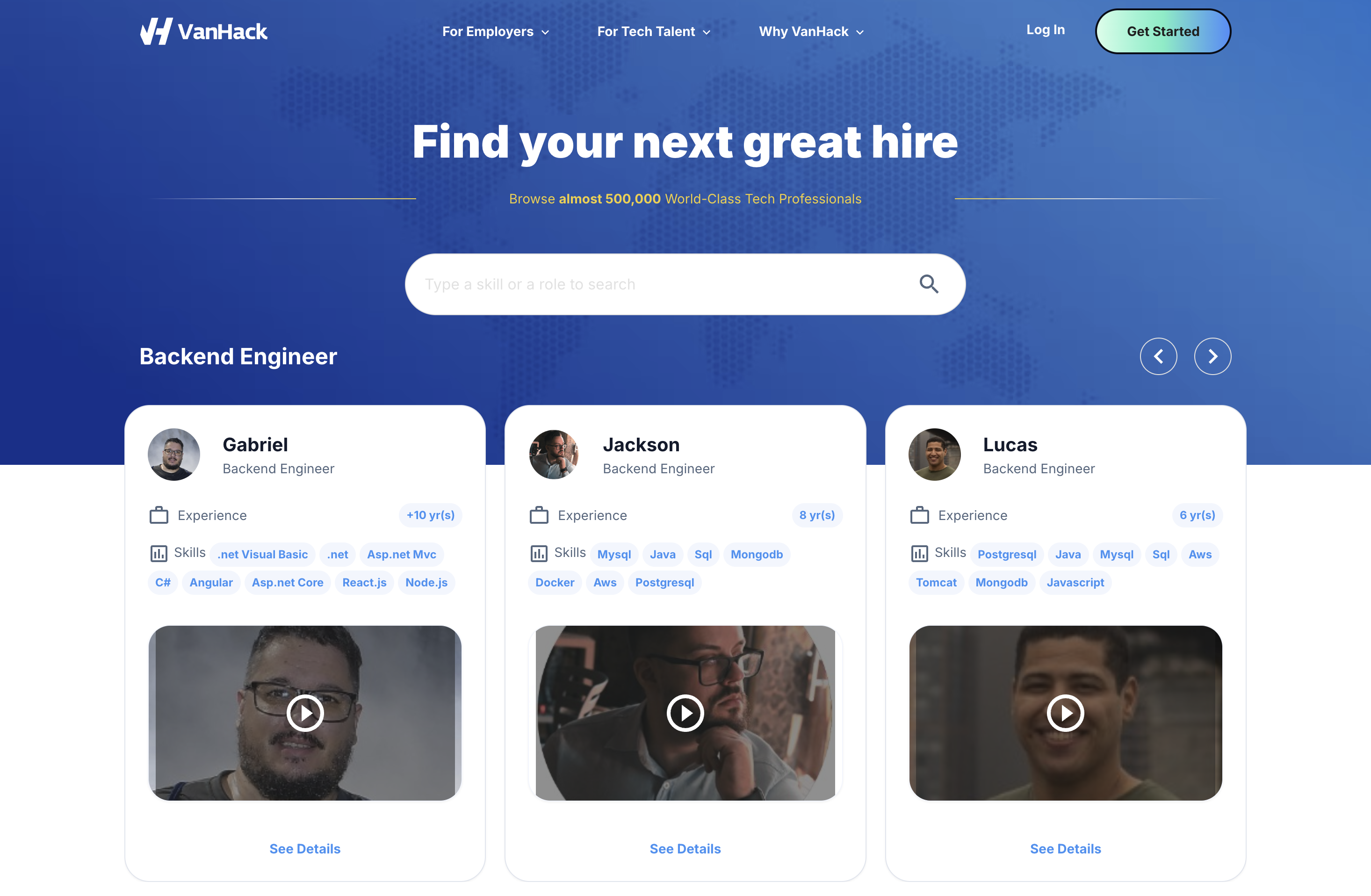US startups often struggle to find skilled engineering talent in a competitive market. Scaling quickly with traditional hiring methods can mean long delays, high costs, and mismatched hires. This article shares seven practical strategies to hire remote LATAM developers using a talent marketplace approach. You’ll learn how to source efficiently with AI tools, vet candidates thoroughly, and integrate international talent into your team. Follow these steps to build your engineering team faster and access high-quality developers at better rates. Ready to streamline your hiring? Recruit faster with VanHack.
Why Choose LATAM Developers for Your US Startup?
LATAM has become a key region for US companies looking for skilled developers at lower costs. Developers in LATAM earn about 75% less than US-based talent, offering major savings while still paying 2-3 times their local average for remote US roles. This benefits both sides: startups save on expenses, and developers gain access to higher pay.
Cost isn’t the only advantage. Time zones in major LATAM countries align closely with US hours, making real-time collaboration easy compared to working with teams in Asia or Europe. Cultural similarities also help, as business practices in LATAM often match North American norms, leading to smoother teamwork across borders.
The region’s focus on tech education and skill development has created a pool of developers experienced in modern tools, cloud systems, and agile methods. LATAM’s growing emphasis on AI and software engineering education produces developers ready for strong remote partnerships. Startups can hire experienced professionals without the high costs of the US market.
Standard hiring methods often miss these benefits due to slow sourcing, weak vetting, and tricky international rules. Talent marketplaces solve this by offering pre-screened candidates, efficient tools for evaluation, and support with compliance. This setup lets startups find skilled developers without the hassle of managing global hiring alone.
7 Practical Strategies to Hire Remote LATAM Developers
1. Target Your Search with AI-Driven Matching Tools
Finding the right LATAM developers means focusing on precision over quantity, especially when top talent gets multiple offers. AI matching tools go beyond basic keyword searches by analyzing context, experience, and cultural fit. These AI systems help match LATAM developers to US company needs quickly and accurately.
These tools look at more than just skills. They evaluate motivation, communication habits, and work style to find better fits. By using detailed data like remote work history and cultural adaptability, AI cuts down on mismatched candidates and saves time in early screening.
Over time, these systems improve as they learn from past hires and feedback. Each successful placement fine-tunes the process, ensuring better matches for your team’s culture and tech needs. This helps startups keep high standards while scaling fast.
Specialized platforms make this even easier. VanHack’s AI tool, “Vanna,” reviews your job needs against a pool of over 500,000 candidates, delivering a shortlist of 3-5 strong matches. Curious to see it in action? Recruit faster with VanHack.

2. Use Multi-Layered Vetting for Skills and Communication
Old-school hiring often depends on resumes and live interviews, which slow things down and offer limited insight. A multi-layered vetting process tests both technical skills and remote work readiness without tying up your schedule.
Video intros are a quick way to check communication. In just 90 seconds, you can assess English skills, confidence, and personality fit. This cuts out early phone calls and lets you evaluate many candidates at once.
Coding tests provide clear proof of technical ability. Using real-world problems instead of theory, these assessments show how candidates solve challenges. They give measurable results to compare applicants directly.
AI-driven technical interviews take this further. Tools conduct recorded sessions where candidates answer questions and solve problems live. The system evaluates their responses for accuracy and clarity, offering deeper insight.
Combining these methods builds a full picture of each candidate before live interviews. Platforms like VanHack include video intros, AI interview results, and coding scores in candidate profiles. Want to skip endless calls? Find top talent with VanHack.
3. Focus on Cultural Fit and Soft Skills for Remote Work
Technical know-how isn’t enough for remote success, especially across cultures. Cultural alignment, initiative, US business familiarity, and clear communication are vital for long-term teamwork. You need to assess soft skills for effective collaboration.
Use structured interviews to explore how candidates solve problems, work in teams, and adapt to remote setups. Ask about handling unclear tasks or explaining tech concepts to non-tech staff. Their answers show readiness for startup challenges.
Check communication beyond language skills. Look at how they explain ideas in videos or writing, join discussions, and document work. These details affect remote team output.
Evaluate initiative by asking how they tackle obstacles or go beyond basic duties. Self-starters shine in remote roles where guidance isn’t always instant. Also, assess cultural awareness for navigating US work norms while adding their unique input.
4. Rely on Regional Experts for Compliance and Payroll
Hiring internationally comes with legal, tax, and admin hurdles that can burden startups. Talent networks with regional partners simplify compliance, saving time and improving returns. Handing these tasks to experts cuts workload and ensures you follow local laws.
Employer of Record (EOR) services manage hiring in LATAM without needing a local entity. They handle payroll, taxes, benefits, and labor rules while you focus on working with developers directly.
Local legal and tax advisors help with contracts, IP protection, and payment setups. They know the variations in employment laws across LATAM, preventing costly mistakes. Immigration support is also key if you plan to bring developers to the US, guiding visa processes smoothly.
Experts can design benefits packages that attract talent without overspending. They understand local systems for healthcare and retirement, helping you stay competitive in the market.
5. Build a Strong Remote Onboarding Process
Onboarding remote LATAM developers well is crucial, especially if they’re new to US teams or remote work. A solid process speeds up productivity, builds cultural connection, and boosts retention.
Start communicating before day one. Share company info, team intros, tech setup guides, and first-week plans. This prepares hires to contribute right away and feel part of the team.
Pair new developers with a mentor or buddy for guidance on work and culture. Set regular check-ins to share knowledge and answer questions. Virtual team activities, like casual chats or group projects, help build bonds despite distance.
Set clear early tasks and success goals. Choose achievable projects to show skills while learning. Provide feedback in the first 90 days to address issues and encourage good habits.
6. Create an Inclusive Remote Team Environment
Remote teams need deliberate efforts to stay connected across time zones and work styles. An inclusive culture ensures LATAM developers feel valued, improving engagement and results.
Use varied communication tools for different needs. Platforms like Slack handle quick chats, Zoom supports video calls, and tools like Loom or Notion work for async updates. Choose tools that are reliable for global users.
Schedule regular meetings, like weekly updates or monthly all-hands, to keep everyone aligned. Rotate times to share timezone challenges fairly. Focus on async habits too, with detailed documentation and updates for smooth collaboration.
Centralized knowledge bases on platforms like Confluence or Notion give easy access to company info and guides. This cuts reliance on live chats and helps remote staff solve issues independently.
7. Track Key Metrics for Global Hiring Success
Data helps refine your LATAM hiring approach and prove value to leaders. Important metrics include productivity, cost savings, hiring speed, retention, and project delivery. Measuring these spots issues and shows the impact of global talent.
Track time-to-hire across each stage, from posting to offer, to find slow points. Offer acceptance rates show if pay or candidate experience needs work. Compare sourcing channels by cost and quality to focus resources.
Measure hire quality with performance, retention, and growth data. Productive developers and faster project delivery highlight business gains. Regular checks spot training needs and recognize top performers.
How Talent Marketplaces Compare to In-House Hiring
|
Feature |
Traditional In-House Hiring |
Specialized Talent Marketplace (e.g., VanHack) |
|
Sourcing |
Manual job boards, internal recruiters, referrals |
AI matching, pre-vetted global talent pool |
|
Vetting |
Resume screens, multiple live interviews |
Video intros, AI interviews, coding results |
|
Time-to-Hire |
6-12 weeks average, often longer |
2-4 weeks with streamlined steps |
|
Cost |
High agency fees (15-25%), staff time |
Subscription or per-hire fees |
Talent marketplaces clearly offer benefits over in-house methods. While managing hiring internally gives control, it takes time and may not yield better results. Platforms like VanHack use AI to deliver vetted candidates, detailed assessments, and compliance support, cutting hiring time and boosting quality over job boards.
Marketplaces handle global rules, cultural checks, and consistent testing better than most internal setups. Building these systems yourself often costs more than partnering with a platform, especially for startups focused on product growth.
Your choice depends on hiring needs and resources. Frequent hiring might justify internal tools, but occasional needs or limited global experience benefit from marketplaces. Align your approach with business goals. Ready to try it? Start hiring with VanHack.
Common Questions About Hiring Remote LATAM Developers
How Much Can We Save Hiring LATAM Developers?
You can save 40-75% on costs compared to US talent, based on experience, skills, and location. Savings come from lower living costs, exchange rates, and local market dynamics. Beyond salary, you cut recruiting expenses, speed up hiring, and often see lower turnover due to job satisfaction.
Factor in all costs for a full picture. LATAM developers may earn 2-3 times local rates with US roles, building loyalty while keeping expenses down. Savings grow with senior hires, who cost 60-70% less than US equivalents but deliver similar quality, letting you build stronger teams sooner.
What Are the Advantages of Talent Marketplaces Over Job Boards?
Talent marketplaces save time by pre-vetting candidates, unlike job boards that flood you with applications to sort through. They offer tools like video intros, AI interviews, and coding tests for deeper insights without extra internal work.
They also manage global compliance, from payroll to labor laws, cutting admin tasks and risks. Continuous feedback on placements improves matching over time, benefiting all users with better hires.
Which LATAM Countries Have the Strongest Developer Talent?
Brazil stands out with a large tech workforce and mature industry. Developers there often have good English skills and adapt well to international teams. Mexico aligns closely with US time zones and business habits, plus proximity aids occasional travel.
Argentina offers developers strong in complex engineering and new tech, thanks to a focus on education. Colombia, Chile, and Peru are growing fast with cost-effective, motivated talent. Focus on individual skills over country stereotypes for the best results, and consider sourcing from multiple regions for diversity.
How Do We Ensure Cultural Fit for Remote LATAM Hires?
Cultural fit depends on communication, adaptability, and work style, not just location. Use structured interviews to ask about handling unclear tasks or team challenges. Their responses show alignment with your culture.
Watch video intros for how they communicate and engage. Trial projects can test real-world fit before long-term commitments. Remember, fit works both ways. Build an inclusive culture that values diverse input while setting clear standards for everyone.
Which Technical Skills Should We Look for in LATAM Developers?
Match skills to your tech stack and goals. LATAM developers cover modern web tools like React, Node.js, and Python, plus cloud systems like AWS or Azure. Look for database knowledge in SQL or NoSQL, and skills in APIs or security if relevant.
Emerging areas like AI or blockchain can add value, but prioritize deep core skills over trendy exposure. Soft technical skills, like clean coding and teamwork, matter just as much for lasting impact.
Scale Your Team Faster with a Talent Partner
Using all seven strategies together takes effort and resources that many startups can’t spare while focusing on product growth. Each tactic helps on its own, but combining them through a partner amplifies the impact on building your engineering team.
Spending time on global hiring logistics pulls leaders away from core work like product strategy. Partnering with a platform shifts this burden, making hiring efficient and strategic.
VanHack offers tools like AI matching with “Vanna,” detailed vetting via videos and tests, and support for global mobility. With a flat $3,000 monthly fee for unlimited hires, costs stay predictable even as you scale. Access to over 500,000 candidates helps you compete in tight markets. Ready to build your team? Start hiring with VanHack today.



